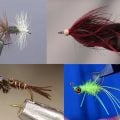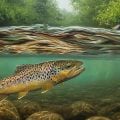“How to Tie the Adams Bugger”
Producer: tightlinevideo
I call this fly the Adams Bugger because I really couldn’t think of anything more clever than that. The idea was to create a streamer with a nice mix of colors—brown, grizzly and grey—figuring it’s the reason an Adams dry is so effective. So far, it’s worked very well swung down and across on trout spey gear, with a 5-feet-per-second sink tip or poly leader.
The fly starts with a size 8 Lightning Strike SN3 3X long streamer hook. After getting the hook firmly secured in the jaws of my tying vise, I load a bobbin with a spool of UTC 140 Denier in black. Get the thread started on the hook shank, leaving a full eye-length behind the back edge of the hook eye, then take a few wraps rearward and snip off the excess tag. Continue taking thread wraps down the shank, ending at the start of the hook bend, just in front of the barb.
A barred natural pine squirrel Zonker strip is used for the tail and back of the fly. The mix of colors on these things is amazing. I’ll separate a whole strip from the rest of the skin, then get hold of the end where the fur points rearward to the back of the fly. Measure to get a length of leather hide a hook shank in length, then separate the fur there. Just a little bit of moisture will help to keep the fur parted. At the part, lay the hide against the near side of the hook and take two tight thread wraps to begin securing it. Lift the front portion of the strip up and take two wraps around just the hook shank, well back toward the first two wraps. Then take two more wraps around the hide. This will help to keep the strip from spinning around on the hook shank. End with your tying thread all the way up the shank, almost to the initial tie-in point.
To keep things simple, the body of the fly is created using variegated, medium-sized chenille in a black and coffee color. A card width-and-a-half makes wrapping comfortable without too much waste. Strip a little bit of the fuzzy stuff from one end to expose the string core. Place the string on top of the hook shank, above your tying thread. Take thread wraps to secure the chenille to the shank, all the way back to the Zonker strip, then go back to where you started. Take touching wraps up the shank with the chenille and, when you reach your tying thread, use it to anchor the chenille then snip the excess off close. Take a few more thread wraps to further anchor the chenille and clean up the tie-down area.
As on the Adams, both brown and grizzly hackle feathers, here fairly webby ones from saddles, are used to hackle the fly. I’m using feathers with fibers in the size 10 range, but there’s definitely some wiggle room here. Pluck a single brown feather and a single grizzly feather free from their skins. With both shiny sides facing you, lay the butt end of one of the feathers on top of the butt end of the other. Strip off fibers from both sides of the stem of both feathers, then strip a few more from just the top sides of the stems. This will help to ensure the feathers wrap correctly. Then snip the excess butt ends off, leaving about 1/8” of bare stem for tie-in.
Lay the bare stems agains the near side of the hook and take tight wraps of tying thread to anchor them. Bend the feathers forward, kind of out of the way, off the front of the fly. Give your bobbin a clockwise spin, as if you’re looking down on it, to cord up, thin and strengthen your tying thread. Then make open spiral wraps over top of the chenille body, all the way back to the Zonker strip. You’ve effectively cross-wrapped the chenille to reinforce it while still leaving it somewhat fluffy.
Get hold of one of the feathers and begin making open spiral wraps with it down the shank, then anchor the tip with thread wraps at the base of the tail. Get hold of the second feather and make a complete 360 degree flat wrap followed by open spiral wraps, through the fibers of the previous feather. Here too, anchor it at the base of the tail with tight thread wraps. Oftentimes, it’s easiest and cleanest to break the excess hackle feathers off rather than using scissors to snip them off. Give your bobbin another clockwise spin and take thread wraps forward through the hackle, cross-wrapping and reinforcing the delicate hackle stems as you go. End with your tying thread immediately in front of the hackle wraps.
Although not essential, I do like to snip off the hackle fibers along the top center of the fly, which will allow the Zonker strip to sit nicely on top once it’s pulled forward. Repeat the same fur-parting and tie-in sequence as you did at the rear of the fly, again, to help keep the Zonker strip from spinning. Lift the Zonker strip up and, using the angled hook eye as a guide, snip the excess off, as close as possible without nicking or cutting your tying thread. Start taking thread wraps to clean up the area. If your thread is slipping on the materials below, a light coating of Veniard’s fly tying wax applied to the thread will give it more grip and really help to create a neat head on the fly.
As soon as everything is well covered, reach for your whip finish tool and use it to do a 5 or 6 turn, back to front, whip finish, seat the knot really well and snip or cut your tying thread free. An ample couple of drops of head cement or here, Sally Hansen Hard as Nails, applied to the wraps will ensure they don’t come unraveled and further neaten up the head of the fly.
This pattern borrows a lot from a Squirrel & Herl Bugger but I think the mix of colors along with fine dark markings really put it over the top. Of course, you can add a bead, cone, wire wraps for weight or even flash, but I kind of prefer them just like this.
"How to Tie Schultz' Red Eye Leech"
"How to Tie the Hare's Ear"











